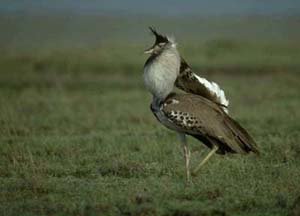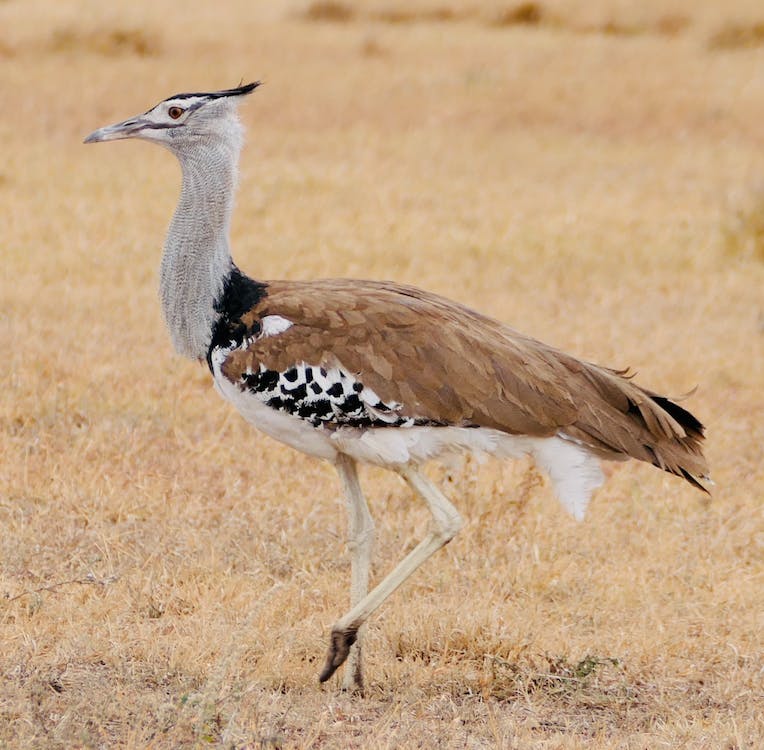The Kori Bustard, also referred to as the Ardeotis kori, is the largest flying bird endemic to Africa. It is a member of the bustard family, which belongs to the order Otidiformes. Like most bustards, the Kori Bustard is a ground-dwelling bird and an opportunistic omnivore.
This bird species was first described by English naturalist William John Burchell in 1822. The name epithet “kori” is derived from the Tswana name for the bird Kgori.
Two subspecies are recognized:
Ardeotis kori kori – This subspecies is native to Botswana, Namibia, Zimbabwe, southern Angola, Mozambique, and South Africa.
Ardeotis kori struthiunculus – Also known as the “Somali kori,” this subspecies is widely distributed across Uganda, Ethiopia, South Sudan, Tanzania, and Kenya.
The Appendix II of CITES and the 2000 Eskom Red Data Book of Birds categorized the species as Vulnerable. The population of the Kori Bustard is also estimated to decline by 10% in South Africa in the next three generations. The numbers of Kori Bustard have been much reduced mainly by hunting. Presently, habitat destruction caused by agricultural development is becoming a major problem for this bird species. Kori Bustards usually end up dead when they collide with overhead power wires. Because of these significant threats, the International Union for the Conservation of Nature )IUCN) Red List listed them as Threatened.
Its seven levels of scientific classification are as follows:
Kingdom: Animalia
Phylum: Chordata
Class: Aves
Order: Otidiformes
Family: Otididae
Genus: Ardeotis
Species: A. kori
The physical characteristics of the Kori Bustard
As Africa’s largest flying bird, an adult Kori Bustard weighs up to 19 kilograms. It is a ground-dwelling bird that possesses a long neck and long feet with three fingers. It has a light brown or grey plumage. The sides of its crown on the head form a black crest. White stripes are present on its eyes. Its chin, neck, and throat are creamy-white with black bands. Its underparts are buff-colored with dark brown vermiculations. Its tail has white or grayish brown bands.
The distribution and habitat of Kori Bustards
Kori Bustards are found across southern Africa, particularly in Namibia, Botswana, southern Angola, and southwestern Zambia. In Zimbabwe, the population is sparse, but they are commonly sighted on the central plateau. Their distribution range starts from the Limpopo River valley to southern Mozambique and the eastern Lowveld of South Africa. Kori Bustards are absent in densely wooded areas and coastal lowlands in southeastern South Africa.
Kori Bustards occur in vast grassy areas with sandy soil, especially in the Kalahari Desert, and short grass near trees and bushes. They also take refuge in plains, arid plateaus, highveld grasslands, lightly wooded savannahs, arid scrubs, and semi-arid deserts.
The behavior of a Kori Bustard
Kori Bustards spend most of the day on the ground, although they sometimes forage in low bushes and trees. They are non-migratory birds, living in the same place as long as there is enough aliment to sustain them. They occur alone or in small groups, and rarely, in larger flocks. As diurnal beings, they forage in low bushes and trees during the daytime.
They are described as shy birds. They are not normally afraid of humans, but they will immediately couch or run away when they are threatened or alarmed.
Kori Bustards have a polygamous mating system, with male mates with different female birds. During the breeding season, which occurs mid-March to August, males gather into a special flock called “lek,” wherein they will perform courtship displays from morning to evening to attract receptive female Kori Bustards. They do not create nests—instead, they just construct a small shallow recess on the ground, where a female Kori Bustard will lay 1-2 eggs. These pale olive eggs will be incubated for about 23 to 24 days. The hatchlings will be primarily taken care of by the mother and rarely by their father. When they reach 4 to 5 weeks of age, the chicks will fledge, but their mother will stay with them until the following year. The young Kori Bustards attain sexual maturity at two years old.
The diet of Kori Bustards
These large birds are omnivores, primarily feeding on both animal and plant species. Their diet mainly consists of reptiles, mammals, seeds, berries, and other birds. For chicks, their primary source of nutrition is insects.
BOTSWANA BIRDS | SOUTH AFRICA BIRDS
NAMIBIA BIRDS | ZAMBIA BIRDS | ZIMBABWE BIRDS


